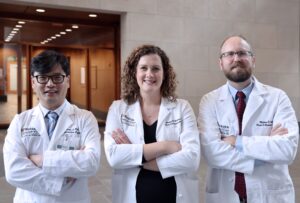Spinal Cord Injury
There is hope for people who have had a cervical level spinal cord injury (SCI) that limits movement in their arms and hands. Two types of surgery offered at WashU Medicine can help improve arm and hand movement that was lost from a cervical SCI. These surgeries are called nerve transfer and tendon transfer.
Surgery may be an option to restore movement, but some surgeries are time-sensitive, which means they are only an option if done within 6-12 months after SCI. Board-certified WashU surgeon Dr. Ida Fox is nationally and internationally known as an expert in nerve transfer and tendon transfer for people who have had cervical spinal cord injuries.
We encourage people who have had a cervical SCI to talk to their health care team about surgery as soon as possible (within 3-6 months after SCI) to keep the window of opportunity open.
Surgery to Improve Movement after SCI
There are two types of surgery that can improve movement in the arms, elbows, wrists and hands after spinal cord injury. Research shows that nerve and tendon transfer surgery can help people regain some movement.
Nerve and tendon transfer surgeries are both done in the hands, arms, or both. Neither surgery is done on the spinal cord itself. In both procedures, the surgeon connects a part of your body that you can move to a part of your body that you can’t move.
Improved arm and hand movement can be useful for doing more things on your own. When considering surgery, it is important to understand the types of procedures and who they can benefit.
Nerve Transfer
Nerve transfer is one type of surgery that can improve movement after cervical SCI. In a nerve transfer procedure, a surgeon connects an extra working nerve to a damaged nerve. The transferred nerve can grow down a new path and carry a signal to tell the muscle to move.
This surgery can help improve movements such as straightening the elbow and wrist, and opening and closing the hands (pinch and grip). This may help people with spinal cord injuries complete daily activities more easily.
In some people, nerve transfer is time-sensitive. In others, nerve transfer surgery can be done even years following a cervical SCI.
Learn more about nerve transfer surgery in this downloadable brochure.
Tendon Transfer
Tendon transfer is one type of surgery that can improve movement after cervical SCI. In a tendon transfer procedure, a surgeon takes an extra working tendon from a muscle that can move and attaches it to one or more tendons that can’t move. After the tendon heals, the working muscle can improve movement that was lost.
This surgery can help improve movements such as straightening the elbow and wrist, and opening and closing the hands (pinch and grip). This may help people with cervical spinal cord injuries complete daily activities more easily.
Tendon transfer can typically be done any time after cervical SCI. This means that, for eligible people, tendon transfer is usually not time-sensitive.
Learn more about tendon transfer surgery in this downloadable brochure.
Effects of Spinal Cord Injury
An average of 17,000 new spinal cord injuries occur in the U.S. every year.
In people with spinal cord injury, the nerves leaving the spinal cord above the level of the injury continue to work. The person still has sensation and control over the muscles in that area.
Nerves that leave the spinal cord below the level of the injury are no longer connected to the brain, so there is no longer a signal from the brain to the nerve to the muscle to make it work.
Sometimes, damage to the spinal cord heals on its own, and a person gets back some movement they have lost from their injury. This is called natural recovery. If a person recovers movement, it usually happens within the first six months after the injury. Then recovery slows down.
Surgery can provide the chance to regain more movement after SCI.
Expert Care for Spinal Cord Injury
Dr. Ida Fox is one of the few surgeons in the world specializing in nerve transfer and tendon transfer surgery for people who have had cervical SCI. These procedures offer hope. They restore movement and function lost aftaer spinal cord injury. Restoring movement often leads to gains in independence. As co-director of the Center for Nerve Injury and Paralysis at WashU Medicine, Dr. Fox has helped hundreds of people regain the use of their hands and arms.


